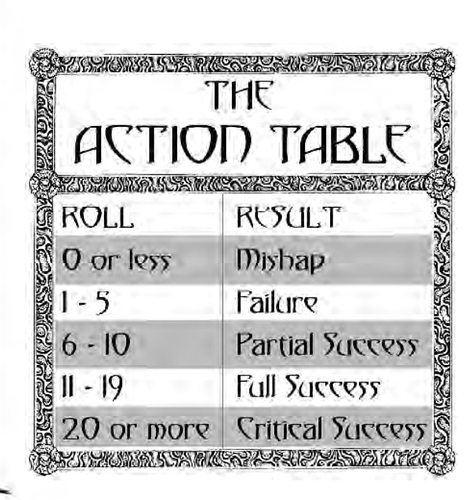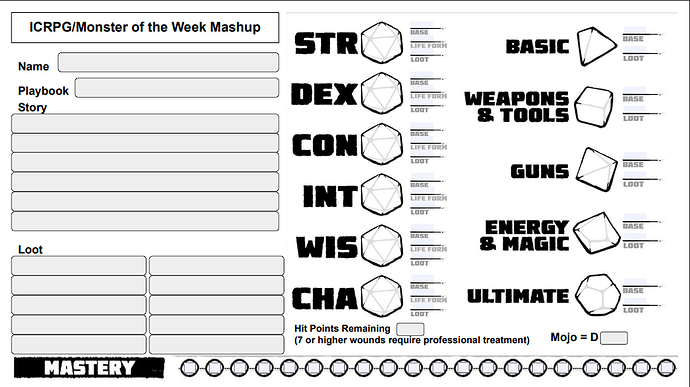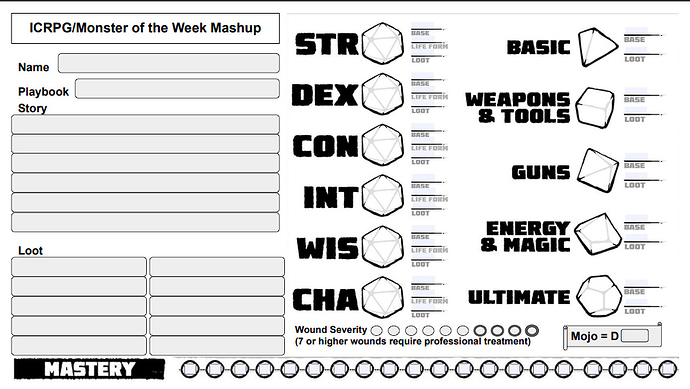About three years ago, I was introduced into the current state of TTRPGs through Dungeon World. The focus on collaborative fiction was the key to engaging my wife and her family (who prefer to use the game as a stage for their characters as opposed to crafting carefully-tuned teams). As someone who is on the opposite end of the spectrum player-wise (Challenge, Exploration, and Social are my top with Expression dead last [Eight Kinds of Fun]), this was a huge change for me, but one I really grew into. DMing meant I got a front seat to the crazy happening at the table, and I got to present the structure which facilitated it.
ICRPG is where I now make my home, but the lessons of PbtA have foundationally affected how I narrate results and think of the game, in general: Dungeon World, along with Apocalypse World, Blades in the Dark, City of Mist, Fellowship, and even Space Wurm vs Moonicorn have left some pretty deep impressions.
There are two elements I want to introduce into my games: Results and Moves (dependent on Results).
RESULTS
With a single Target, it seems like it would be a lot easier to apply the single, consistent result “table”:
= Target is a success,
1-2 below Target is success with complications,
3+ below Target is a failure
Thanks to ICRPG’s streamlined panel of dials and toggles, it’s a simpler process to fairly adjust the mechanical results to meaninfully reflect how things didn’t quite go as planned. It’s also a way of taking the sting out of getting just under Target.
I’m planning on doing this next week with a kids’ game (sixth graders) I’m running, but was wondering if any of y’all had done this yet and could report how it worked out.
MOVES
This wouldn’t be much different than other “Moves as LOOT” ideas, but the way PbtA moves are written makes them more open for interpretation, with a focus more on facilitating creative solutions than what might be functionally plausible.
Take Alex, a stereotypical Chinese kid who’s a mix of Short Round from IJ2 and Richard Wang from The Goonies. He’s got moxy and a mind for inventions, somehow finding ways to store a kajillion of them on his person. They might not always work and can fail fantastically, but they are clutch when they work.
One way that we could render this concept is through a handful of LOOT cards with different inventions. This would work, but to me it limits the creativeness of the solution in the moment to the forethought of the player, which likely isn’t on the same plane of existence as Alex (nor should it be; Alex is a prodigy whiz kid). It also works against the narrative whimsy that occurs as a result of inspiration in the heat of a conflict and the “what the heck a spring-released boxing glove?”
A way that gives this creative license to the player (while providing a proportionate amount of risk) is making a PbtA move, such as:
“When you use a mechanical gizmo as part of an unconventional solution, roll +INT. Tell the table about the gizmo, where you were keeping it, and what you want to accomplish.
=> TARGET means your genius comes through yet again!
1-2 under TARGET means your invention worked!.. kind of. The GM will say in what comical way things didn’t work quite how you’d hoped.
3+ under TARGET means that in your moment of need, your invention failed. The GM will say how your solution went completely sideways.”
So! My questions to you:
- Has anyone integrated PbtA-type elements into ICRPG? How did it go?
- How does the idea sound? Any concerns about impacting balance, making it too fiddly, or going against the design spirit/aesthetic of ICRPG?






